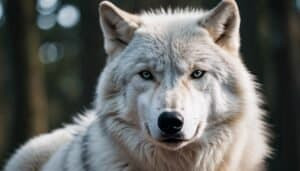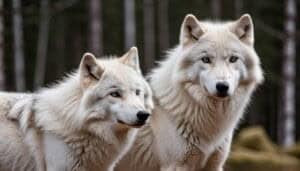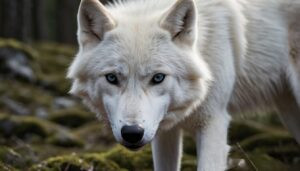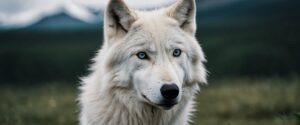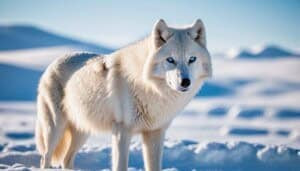Introduction
Arctic wolves, adapted to the harsh conditions of the Arctic, rely on their keen sense of taste for survival. This article explores the multifaceted role of taste in their lives, from identifying and selecting food to its impact on social behaviors within packs
We will delve into how taste influences their hunting strategies, compare their taste sensitivity to other canines, and examine the adaptations that enable them to taste in extreme cold
Additionally, we will look at recent research on Arctic wolves’ taste receptors and how their diet over time has shaped their sense of taste
The Role of Taste in an Arctic Wolf’s Life
Arctic wolves, like other canines, rely on their senses to navigate their environment and find food. Taste plays a crucial role in this process, helping them identify edible food, distinguish between different types of meat, avoid spoiled or toxic food, and develop preferences that influence their hunting strategies
Identifying Edible Food
One of the primary functions of taste in Arctic wolves is to help them identify edible food. In the Arctic’s harsh environment, food sources can be scarce, and wolves must make quick decisions about what is safe to eat
Their taste buds allow them to discern the nutritional value of different foods, guiding them to consume what is most beneficial for their survival. This is especially important when they encounter unfamiliar prey or scavenge from carcasses left by other predators
Distinguishing Between Different Types of Meat
Arctic wolves can distinguish between various types of meat, which is vital for their dietary needs. Different prey animals offer varying levels of nutrients, and wolves use their sense of taste to select the most nutritious options
For instance, the meat of larger prey like caribou or muskoxen is rich in fat and protein, providing essential energy for survival in the cold. By differentiating between meats, wolves can optimize their diet to maintain their health and energy levels
Avoiding Spoiled or Toxic Food
Another critical function of taste in Arctic wolves is to avoid spoiled or toxic food. Consuming rotten meat or poisonous substances can be deadly, and wolves must be able to detect these dangers quickly
Their taste buds are adapted to recognize the bitter and sour flavors often associated with spoilage and toxins, helping them avoid potentially harmful foods. This ability is particularly crucial when food is scarce, and the risk of encountering unsafe food increases
Preference for Specific Prey
Taste preferences also influence Arctic wolves’ selection of prey. They may develop a preference for certain animals based on taste, which can shape their hunting patterns
For example, if a wolf finds the meat of a particular prey species especially palatable, it may target that species more frequentlyThis preference can lead to specialized hunting techniques and strategies tailored to capture preferred prey, enhancing the efficiency of their hunts
Impact on Hunting Strategies
The taste preferences of Arctic wolves impact their hunting strategies in several ways. If wolves have a strong preference for specific prey, they may hunt in areas where these animals are more abundant
Additionally, their sense of taste can drive cooperative hunting behaviors, where pack members work together to capture larger prey that provides a more desirable taste and higher nutritional value. These strategies not only improve their chances of a successful hunt but also ensure that the pack gets the best possible nourishment
Development and Adaptations of Taste in Arctic Wolves
Arctic wolves possess unique adaptations that allow them to thrive in their cold and harsh environment. Their sense of taste has developed to meet the specific needs of their survival, enabling them to effectively identify and consume the right food sources
This section explores how their taste sensitivity compares to other canines and the adaptations they have for tasting in extreme cold
Taste Sensitivity Compared to Other Canines
Arctic wolves’ taste sensitivity is comparable to that of other canines, though they have certain adaptations tailored to their environment. Canines generally have fewer taste buds than humans, but their taste buds are highly specialized for detecting specific flavors
Arctic wolves can taste salty, sweet, sour, and bitter flavors, with a particular sensitivity to the taste of meat. This sensitivity helps them identify different types of prey and ensure they are consuming high-quality, nutritious food
Compared to domestic dogs or wolves in more temperate climates, Arctic wolves may exhibit heightened sensitivity to certain tastes that are crucial for their survival. For instance, the ability to detect subtle differences in the flavor of meat can help them determine the freshness and nutritional value of their food, which is essential in an environment where food sources can be limited and sporadic
Adaptations for Tasting in Cold Environments
Arctic wolves have several adaptations that allow their sense of taste to function effectively in extreme cold. One significant adaptation is the maintenance of their taste bud functionality despite low temperatures. In freezing conditions, many animals experience reduced sensory perception, but Arctic wolves’ taste buds are adapted to remain sensitive and responsive
Their saliva composition also plays a role in their tasting ability. The saliva of Arctic wolves contains enzymes that help break down food quickly, allowing them to taste and process nutrients efficiently. This is particularly important when consuming frozen meat, which requires additional effort to chew and digest
Additionally, Arctic wolves have a well-developed olfactory system that complements their sense of taste. The sense of smell and taste are closely linked, and a strong sense of smell enhances their ability to detect and identify food. In the Arctic, where food sources are often hidden under snow and ice, the combination of taste and smell allows wolves to locate and evaluate potential meals more effectively
These adaptations ensure that Arctic wolves can rely on their sense of taste to make critical decisions about food consumption, even in the most challenging conditions. Their ability to taste effectively in cold environments is a testament to their evolutionary success and resilience in one of the world’s most extreme habitats
Taste and Social Behaviors
Arctic wolves live in complex social structures that rely heavily on cooperation and communication. Their sense of taste plays a significant role in shaping their social behaviors, from pack dynamics to food sharing
This section delves into how taste influences these interactions and contributes to the overall cohesion and survival of the pack
Role in Pack Dynamics
The sense of taste helps to reinforce social bonds within the pack. When Arctic wolves hunt and feed together, the shared experience of eating the same food strengthens their unity. Wolves often engage in communal feeding, where they share their prey with other pack members. This not only ensures that all members are nourished but also reinforces their social hierarchy and relationships
Taste also plays a role in the teaching behaviors observed in packs. Adult wolves introduce pups to different types of food, guiding them on what is safe and nutritious to eat
This mentorship involves allowing the pups to taste various prey, helping them develop their preferences and understanding of edible food. Through these shared meals, taste becomes a medium for passing down crucial survival skills and knowledge
Influence on Food Sharing
Food sharing is a critical social behavior among Arctic wolves, and taste influences how and what they share. When a kill is made, the alpha wolves typically eat first, followed by subordinate members
The taste of the meat and its nutritional value determine the order in which the food is distributed. High-ranking wolves often get the most desirable parts of the prey, while lower-ranking members consume what remains
Taste preferences can affect which parts of the prey are consumed first and how leftovers are managed. For example, organs rich in nutrients and flavor, such as the liver, are highly sought after and often eaten first by the dominant wolves. This behavior ensures that the most critical nutrients are consumed by those leading the pack, thereby maintaining their strength and leadership
Additionally, food sharing facilitated by taste preferences helps in the formation and maintenance of alliances within the pack. Wolves may share particularly tasty or nutritious parts of their prey with specific pack members, strengthening bonds and loyalty. These interactions are vital for the cohesion and cooperative functioning of the pack
Research and Evolution of Taste in Arctic Wolves
Scientific research into the taste receptors and dietary evolution of Arctic wolves provides valuable insights into how these animals have adapted to their environment over time. Understanding these aspects can also inform conservation efforts and ecological studies
Recent Studies and Findings
Recent studies on the taste receptors of Arctic wolves have focused on their ability to detect and respond to different flavors. Researchers have found that, like other canines, Arctic wolves have taste receptors that allow them to detect sweet, salty, bitter, and umami flavors. These receptors are crucial for identifying nutritious food and avoiding harmful substances
One interesting finding is the adaptation of their taste receptors to the Arctic environment. Studies suggest that Arctic wolves may have a heightened ability to taste and prefer high-fat content in their prey
This preference is beneficial in their cold habitat, where fat provides a necessary source of energy and insulation. Researchers have also explored the genetic basis of these taste preferences, revealing specific gene variations that may enhance their ability to taste and metabolize fat
Historical Diets and Taste Evolution
The historical diet of Arctic wolves has played a significant role in shaping their sense of taste. Over centuries, Arctic wolves have evolved to consume a diet primarily consisting of large ungulates like caribou and muskoxen. This diet is rich in protein and fat, which are crucial for survival in the harsh Arctic climate
The evolution of their taste preferences likely followed the availability of these prey animals. Wolves that could better detect and prefer the taste of high-fat and high-protein prey would have had a survival advantage, leading to the development of taste receptors finely tuned to these nutrients
This evolutionary process ensures that Arctic wolves are well-equipped to seek out and consume the most beneficial food sources in their environment
Current Diet and Its Effects
Today, the diet of Arctic wolves continues to be dominated by large mammals, but it can also include smaller animals and occasional vegetation. The current diet reflects the availability of prey in their habitat, which can vary seasonally
During the summer months, when prey is more abundant, wolves may consume a wider variety of foods, while in the winter, their diet becomes more focused on large prey
The ongoing adaptation of their taste receptors to their diet is evident in their preference for fresh, fatty meat. This preference impacts their hunting behavior, social dynamics, and overall health. Understanding these dietary patterns is essential for monitoring the health and sustainability of Arctic wolf populations
Implications for Conservation and Ecology
Research on the taste receptors and dietary habits of Arctic wolves has significant implications for conservation and ecology. By understanding how these animals select and consume their food, conservationists can better manage their habitats and ensure the availability of key prey species
This knowledge is particularly important as climate change and human activities continue to impact Arctic ecosystems
Additionally, studying the evolution of taste in Arctic wolves can provide insights into the broader ecological relationships within their environment. For example, the preference of Arctic wolves for certain prey can influence the population dynamics of these species, affecting the entire food web
Conservation efforts must take these intricate relationships into account to maintain a balanced and healthy ecosystem
Conclusion
In conclusion, the sense of taste in Arctic wolves is a vital adaptation that supports their survival in one of the most challenging environments on Earth. Their ability to identify edible food, distinguish between different types of meat, and avoid spoiled or toxic substances ensures they maintain a nutritious diet. Taste preferences influence their hunting behavior and pack dynamics, fostering cooperation and social bonds
Arctic wolves’ taste sensitivity and adaptations for tasting in extreme cold highlight their evolutionary success. Comparative studies with other canines show their specialized taste receptors, which are crucial for detecting high-fat prey necessary for energy in the Arctic
Furthermore, research into their taste receptors and historical diet evolution provides insights into their dietary adaptations and informs conservation efforts
Understanding how Arctic wolves use their sense of taste deepens our knowledge of their ecology and helps develop strategies to protect these magnificent animals. Conservationists can use this information to manage habitats and prey availability, ensuring the health and sustainability of Arctic wolf populations
As the Arctic environment continues to change, the resilience and adaptability of Arctic wolves remain a testament to their remarkable survival skills


